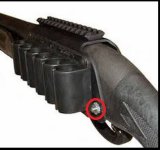re: a problem with a Winchester 1300 shotgun
Before I get into the problem with the Winchester 1300 defender. A bit about me. What I know about firearms I got from Air Force basic training. My MOS was Electronics, 2 way radios and communations. I hold an AA degree in electronics, 2 way radio, tv, vcr and computer repair. I can look at a mechanical blow up picture and figure out how to take something apart and put it back together. Enough about me.
The Winchester 1300 defender shotgun came with a 5 shot tactical holder bolted to the left side. Someone replaced the trigger assembly knockout pin with a bolt that screws into tactical holder on the left side (see the nut with a red circle around it in the attached picture). The shotgun worked just fine that way. When I field striped the shotgun for cleaning after the last time at the range. I tightened that screw a bit to much and bent something. The shotgun still fires but pump won't move period to cycle the old round out and put a new round in without pushing up the manual release button behind the trigger guard. I took it to a local person that knows how to fix it. He knows what part has to be bent back in shape or replaced. But he is a packrat when it comes to books and his work bench is filled with books and he won't clean them off. So I am on my own. He will check the shotgun after I am done working on it to see if it was done right. I also have 2 dummy shotgun shells to test the loading and unloading mechanism with. My problem is that I don't have a 100% clear picture in my head as to which part needs to be bent back or replaced. Can someone please help me.
Steve
Before I get into the problem with the Winchester 1300 defender. A bit about me. What I know about firearms I got from Air Force basic training. My MOS was Electronics, 2 way radios and communations. I hold an AA degree in electronics, 2 way radio, tv, vcr and computer repair. I can look at a mechanical blow up picture and figure out how to take something apart and put it back together. Enough about me.
The Winchester 1300 defender shotgun came with a 5 shot tactical holder bolted to the left side. Someone replaced the trigger assembly knockout pin with a bolt that screws into tactical holder on the left side (see the nut with a red circle around it in the attached picture). The shotgun worked just fine that way. When I field striped the shotgun for cleaning after the last time at the range. I tightened that screw a bit to much and bent something. The shotgun still fires but pump won't move period to cycle the old round out and put a new round in without pushing up the manual release button behind the trigger guard. I took it to a local person that knows how to fix it. He knows what part has to be bent back in shape or replaced. But he is a packrat when it comes to books and his work bench is filled with books and he won't clean them off. So I am on my own. He will check the shotgun after I am done working on it to see if it was done right. I also have 2 dummy shotgun shells to test the loading and unloading mechanism with. My problem is that I don't have a 100% clear picture in my head as to which part needs to be bent back or replaced. Can someone please help me.
Steve

